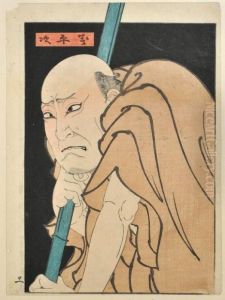Gostei Hirosada Paintings
Gosotei Hirosada was a Japanese ukiyo-e artist, primarily known for his work in the Osaka printmaking tradition during the late Edo period. Hirosada's exact birth date remains uncertain, but his active period, particularly in the 1840s and 1850s, is well-documented through his prolific output of actor prints (yakusha-e) and related genre scenes. Hirosada is often considered one of the last great masters of the Osaka School of printmaking, a regional variant of the broader ukiyo-e movement that was centered in Edo (modern-day Tokyo).
Hirosada’s work is characterized by its focus on the kabuki theater, capturing the expressive features and dramatic postures of actors in mid-performance. His prints are notable for their intricate details, vivid portrayal of emotion, and the use of a richer, more nuanced color palette compared to his contemporaries in Edo. This was partly due to the technical innovations and distinctive aesthetic preferences of the Osaka artists, who often produced prints in smaller editions, allowing for a higher quality of printing and a greater attention to detail.
During his lifetime, Hirosada witnessed significant social and political changes, including the increasing restrictions on the production and subject matter of ukiyo-e prints imposed by the Tokugawa shogunate in an attempt to enforce social order. Despite these challenges, he managed to maintain a successful career, adapting his style and subjects to meet the changing tastes and regulations of the time. Hirosada's ability to convey the essence and energy of kabuki theater, combined with his technical skill, has earned him a lasting place in the history of Japanese art.
After his death in 1865, Hirosada's work, like much of the Osaka print tradition, was overshadowed by the artists of Edo, particularly as Japan opened to the West and tastes shifted towards the works of artists such as Hokusai and Hiroshige. However, in recent years, there has been a growing appreciation for Osaka prints and a reevaluation of Hirosada’s contribution to the ukiyo-e genre. Today, his prints are celebrated for their exceptional quality and are considered key examples of the art of the late Edo period. They are held in numerous museum collections worldwide, where they continue to be studied and admired for their beauty and historical value.
